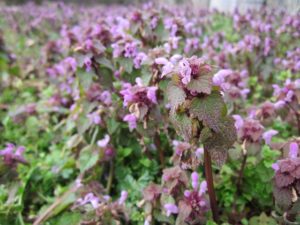
Do you know your Maryland lawn weeds? Get to a little more about them here.
The yards and streets are coming alive! Plants, lawns, and trees are greening up, and the time to care for the landscape has come once again. Weeds are not absent from the scene; they appear in both lawns and gardens all over Maryland. Identifying your common garden weeds can help you choose the best herbicide or inform you how to take advantage of their dietary or medicinal applications. Below is a list of 6 of the most common garden weeds in the state.
1. Hairy Bittercress
You may have seen these all your life, and never knew they had a name. Hairy Bittercress appears in little clumps with tall, spindly stems sticking upward, topped by delicate, tiny white flowers. They like to grow in upturned, moist soil, which means they are a common sight in wetter conditions and greenhouses. Thankfully, they are easy to uproot. Although they have “bitter” in their name, their tender greens are edible with a mild, peppery taste.
2. Purple Deadnettle
Purple deadnettle has scallop-shaped leaves with columns of foliage topped by brown leaves and purple flowers. Belonging to the mint family, they are aggressive and rapid growers among lawns. A healthy, thick lawn is the best preventative measure one can take against these plants.
3. Common Chickweed
Chickweed is another fast-spreading plant. Growing close to the ground, its stems branch out and plunk down new root systems into the soil. They are most distinguishable by the many little white flowers they have. They are also edible and can be used for microgreens or tea.
4. Dandelion
Everyone knows the bright yellow heads of the dandelions. These plants may not be as aggressive as people once thought, and have many known benefits for wildlife and people alike. If you are not interested in using dandelions for tea or an ingredient in your cuisine (every part of the plant is edible,) you can at least enjoy the pops of color if it is not too much of a bother.
5. Clover
Clover, another common garden weed, also can help aerate the soil and prevent erosion. It also adds nitrogen to the soil, since it is a member of the pea family. To remove this weed from your lawn, use an herbicide that works for the type of grass you have.
6. Indian Mock Strawberry
This low-growing plant does not grow real strawberries, as the name implies, but their fruit is indeed edible. Their red fruits are tasteless, but the common conception that they are toxic is inaccurate. As they spread through their stolons (runners,) the best method of removing is by hand or an appropriate weed-pulling tool.
Choose Edwards Lawn & Home
For the past thirteen years, Edwards Lawn and Home has been offering premier residential and commercial services to improve your property all year long. The options are endless from a new patio to a backyard fire pit, let the winners of Angie’s List Super Service Aware serve you! If you’re interested in finding out more about our services or getting a quote, you can contact us online or give us a call at 443-341-6539. For more information about our services or DIY tips and tricks follow us on Facebook, Twitter, LinkedIn, YouTube and Houzz.